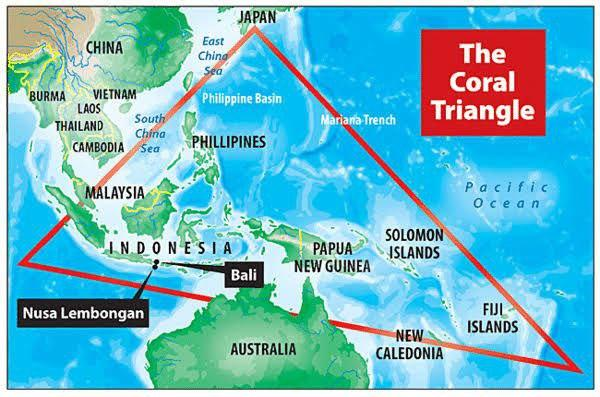The Coral Triangle: Vital Marine Ecosystem Under Threat
Why in the news?
The Coral Triangle is in the spotlight due to rising environmental threats like unsustainable fishing, pollution, and climate change, raising urgent conservation needs discussed at COP16 for biodiversity protection.
Overview and Significance of the Coral Triangle :
- Referred to as the “Amazon of the seas,” the Coral Triangle covers over 10 million square kilometres.
- It spans Indonesia, Malaysia, Papua New Guinea, Singapore, the Philippines, Timor-Leste, and the Solomon Islands.
- Known for its rich biodiversity, the region hosts 76% of the world’s coral species and supports over 120 million people dependent on its resources.
Key Threats and Environmental Challenges:
- Unsustainable Fishing: Overfishing and destructive practices are depleting fish stocks and damaging coral ecosystems.
- Pollution: Coastal development introduces pollutants that harm coral health and degrade marine habitats.
- Climate Change: Rising temperatures cause coral bleaching, where corals expel their symbiotic algae, weakening their resilience and survival.
- Coral reefs, formed by colonies of polyps, depend on algae called zooxanthellae for energy through photosynthesis, which is crucial for their survival and growth.
Call for Conservation at COP16:
- At the 16th Conference of Parties (COP16) under the Convention on Biological Diversity, experts highlighted the urgency of protecting the Coral Triangle.
- A report underscored the need to mitigate damage from oil and gas activities, which further threaten the delicate marine environment.
- Conservation efforts are crucial to preserving biodiversity and securing the livelihoods of local communities who rely on the Coral Triangle’s resources for food and income.
About Coral Reefs:
- Coral polyps, tiny marine organisms, belong to the cnidaria group (along with hydras, jellyfish).
- Polyps form symbiotic relationships with zooxanthellae algae, sharing nutrients and photosynthesis benefits.
- Coral reefs are built as polyps secrete calcium carbonate, cementing coral and debris to form reef structures (fringing, barrier, and atolls).
Importance:
- Rich biodiversity, hosting 25% of marine species, called “rainforests of the sea.”
- Protect shorelines, support fisheries, and promote tourism, offering economic and cultural value.
Key Global Initiatives:
- International Coral Reef Initiative (ICRI): Aims for sustainable coral reef management, capacity building, and raising awareness (founded in 1994, India is a member).
- Global Coral Reef Monitoring Network: Under ICRI, provides scientific data for reef conservation.
- International Coral Reef Action Network (ICRAN): Shares best practices globally for reef ecosystem management.
- UNEP: Includes coral reef conservation as an ecosystem-based coastal protection measure.
- Coral Triangle Initiative: Partnership among six Southeast Asian countries for reef conservation.
Coral Conservation in India:
- Protected under Wildlife Protection Act, 1972 and Environmental Protection Act, 1986.
- Key sites for conservation include Andaman & Nicobar Islands, Lakshadweep Islands, Gulf of Kutch, and Gulf of Mannar.
- Coral Bleaching Alert System (CBAS) since 2011, monitors thermal stress.
- The National Coral Reef Research Centre in Port Blair promotes research and information sharing.





